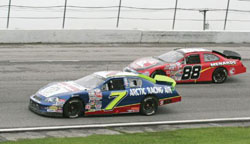Ronsguide.com
Race car safety features
 Sport car safety is an evolving science constantly. Every year racing organization updates their safety regulations for race cars. The evolution in race car safety is increasing in recent years because all the racers’ live depends on the safety equipment and safety systems. The recently developing cars push the physical limitations of automotive engineering. Designing these cars is a complex task that involves dozens of designers, mechanics and engineers. The racecar driver shows his professional skills by driving this car on the track at speeds that would frighten the most people. These cars have the ability to reach speeds of more than 200 mph. The average street car is equipped with air bags and seatbelts to protect occupants.
Sport car safety is an evolving science constantly. Every year racing organization updates their safety regulations for race cars. The evolution in race car safety is increasing in recent years because all the racers’ live depends on the safety equipment and safety systems. The recently developing cars push the physical limitations of automotive engineering. Designing these cars is a complex task that involves dozens of designers, mechanics and engineers. The racecar driver shows his professional skills by driving this car on the track at speeds that would frighten the most people. These cars have the ability to reach speeds of more than 200 mph. The average street car is equipped with air bags and seatbelts to protect occupants.
The NASCAR racing car is designing with a skeleton of strong metal tubing covered with thin, metal sheeting. These cars are equipped with numerous safety devices to avoid accidents and crashes. The important thing to survive a crash is for the cars to remove the energy from the driver’s body as slow as possible. The structure of a street car is designed as to absorb a lot of energy and providing other safety devices such as seat belts, air bags and more time to slow the driver’s body down.
The NASCAR race car incorporates three techniques to offer safety measures. They are front clip, rear clip and middle section. The front and rear clip are produced from thinner steel tube so that they will crush when the car hits another car. The middle section is built to be strong enough to maintain its integrity. The front clip pushes the engine out of the bottom of the car during an accident rather than into the driver’s compartment. The seat is designed to keep the driver inside the roll cage of the car. It should keep the driver from hurting by any hard thing during a crash. It must bend to absorb some of the energy. Several deaths occurred when driver still in their seats were thrown from the cars. To solve this problem, NASCAR requires the seat to be attached at several points directly to the tubular structure that forms the roll cage. The shape of the seat is too important. Seats provide support during a crash by spreading the load out over the entire rib cage. Seats now provide better support because the shoulders are more durable than rib cage.